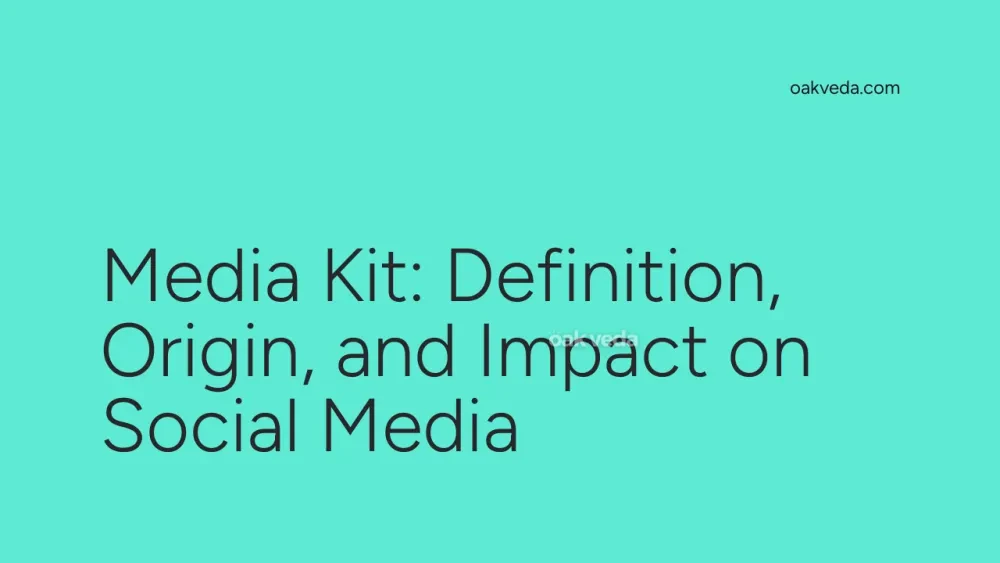
What is a Media Kit?
A media kit, in the context of social media, is a comprehensive promotional document that showcases an influencer's brand, audience, and marketing potential. It serves as a digital portfolio, providing key information about an influencer's social media presence, achievements, and value proposition to potential partners, brands, and PR agencies.
Origin and Development of Media Kits
Media kits have their roots in traditional public relations and marketing practices. However, with the rise of social media influencers and content creators, they have evolved to meet the unique needs of the digital landscape. As influencer marketing gained prominence, media kits became essential tools for creators to professionally present their personal brands and audience reach.
How Media Kits Work
Media kits function as a one-stop resource for brands and businesses interested in collaborating with influencers. They typically include:
- An overview of the influencer's brand and niche
- Detailed audience demographics and reach statistics
- Content samples and style information
- Past collaborations and case studies
- Rates and services offered
- Contact information
By providing this information upfront, media kits streamline the process of initiating partnerships and help influencers stand out in a competitive market.
Types of Media Kits
While the core elements remain consistent, media kits can vary based on the influencer's niche and platform focus:
- Multi-platform media kits: Showcase presence across various social media platforms
- Platform-specific media kits: Tailored for influencers who specialize in a single platform (e.g., Instagram, YouTube, TikTok)
- Niche-focused media kits: Emphasize expertise in specific areas like fashion, tech, or fitness
Popular Examples of Media Kits
Many successful influencers have leveraged well-crafted media kits to secure brand partnerships. While specific examples are often confidential, some influencers have shared insights into their media kit strategies:
- Fashion bloggers often include high-quality lifestyle images and detailed style information
- Tech reviewers might showcase their equipment and production capabilities
- Food influencers typically highlight their recipe development process and food photography skills
Impact of Media Kits on Social Media Culture
Media kits have significantly impacted social media culture by:
- Professionalizing influencer marketing
- Encouraging transparency in brand-creator relationships
- Empowering creators to advocate for fair compensation
- Facilitating more strategic and data-driven partnerships
Controversies Surrounding Media Kits
While media kits are generally viewed positively, some controversies exist:
- Accuracy of metrics: Concerns about inflated or misrepresented audience data
- Standardization: Lack of industry-wide standards for media kit content and format
- Over-reliance on numbers: Debate over the importance of engagement quality versus quantity
How Brands and Influencers Use Media Kits
Brands use media kits to:
- Evaluate potential partnerships
- Understand an influencer's audience alignment
- Assess the potential ROI of collaborations
Influencers use media kits to:
- Showcase their unique value proposition
- Demonstrate professionalism and business acumen
- Streamline the pitching process to brands
Future Trends Related to Media Kits
As the influencer marketing landscape evolves, we can expect to see:
- Increased integration of real-time analytics
- More interactive and multimedia-rich media kit formats
- Greater emphasis on niche expertise and micro-influencers
- Incorporation of AI-driven insights and predictive metrics
FAQs about Media Kits
Q: How often should a media kit be updated? A: Media kits should be updated regularly, ideally every 3-6 months or whenever significant changes occur in an influencer's metrics or brand partnerships.
Q: Are media kits only for large influencers? A: No, media kits are valuable for influencers of all sizes, including micro-influencers and niche content creators.
Q: What's the ideal length for a media kit? A: Media kits should be concise yet comprehensive, typically ranging from 2-5 pages or slides.
Q: Should rates be included in a media kit? A: While not mandatory, including a rate card or price range can help set clear expectations and filter serious inquiries.
In conclusion, media kits have become indispensable tools in the social media influencer ecosystem. They bridge the gap between creators and brands, facilitating more transparent, efficient, and mutually beneficial partnerships. As the digital landscape continues to evolve, media kits will likely adapt, incorporating new technologies and metrics to remain relevant and effective in the world of influencer marketing.
You may be interested in:
- Social Media Monitoring: Definition, Origin, and Impact
- SMH: Definition, Origin, and Impact on Social Media
- YouTube Shorts: Definition, Origin, and Impact
- Vanity Metrics: Definition, Origin, and Impact on Social Media
- Earned Media Value: Definition, Origin, and Impact
- Rent-Free: Definition, Origin, and Impact on Social Media

